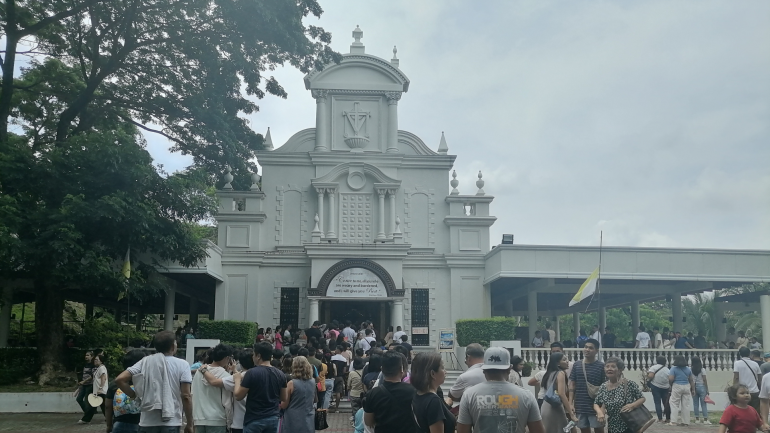Philippines' Monasterio de Tarlac draws pilgrims to fragment of Christ's cross Inbox

Hundreds of pilgrims from Manila and nearby provinces climb to the monastery to hear Mass and touch the chest containing a piece of Christ's cross.
Hundreds of pilgrims visit and venerate a small crypt under the altar of the tiny monastery of the Servants of the Risen Christ Monastic Community.
In a complex atop Mt. Resurrection in San Jose, a town in the province of Tarlac about three hours drive northeast of Manila, the religious community built the chapel, the monks' dormitory, and other structures.
Only 11 brunette wooden pews, built with stained glass windows, seat a limited number of people in the chapel. Six pews are on the right side, five on the left.
However, hundreds of pilgrims from Manila, the country's capital, and neighboring provinces climb to the monastery to hear Mass and get the rare opportunity to touch the chest containing a piece of the cross Christ was crucified on.
The two open, pillared galleries on each side of the chapel serve as its right and left wings. Each can seat about fifty people.
But during the Mass, hundreds more pilgrims stand at the entrance and under the trees at the complex's square, as the interior of the chapel and its galleries cannot accommodate all the numbers.
The priest delivers an inspirational message before the Mass ends, encouraging the pilgrims to overcome the various challenges they face.
After the Mass, the pilgrims are given the chance to see and touch the chest containing a piece of the same cross Christ was crucified on.
The contemplative monks' hollow voices play a recorded chant.
On silver and golden plates, the monks offer each pilgrim a few moments to whisper a prayer at the chest.
The crypt has a transparent glass front wall where pilgrims can view the chest from the pews. From behind the altar, pilgrims can touch the chest.
After this experience, the pilgrims can explore and take photos at the recreational and religious spots around the monastery.
Outlets offer food, coffee, refreshments, and religious items.
A few locals sell on-foot honey in empty gin bottles.
The chapel is all white, except for a few highlights in brunette brown.
The pilgrims have to climb seven steps to the porticoed entrance.
The facade exhibits simplicity, yet it exudes class. However, inside the chapel, the white and golden retablo and altar are richly ornate.
At the chapel's end, the retablo stands in front of a wine-red wall.
In 2000, the monastery laid its foundation. The first Mass and the erection of the first cross in the place were held in the same year.
In 2002, they blessed the 30-foot statue of the Risen Christ, which overlooks villages and rice fields.
In 2004, the monks blessed the chapel and the 12-room dormitory.
The chapel enshrined a fragment of Christ's cross on January 30, 2007.
The Monasterio de Tarlac is part of Barangay Lubigan in San Jose, Tarlac.
Motorists also come to the monastery to have their new cars blessed.
The parking lot was unable to accommodate the volume of pilgrims' vehicles. Many have to park on the sides of the main road, located deep below the monastery complex.
Mount Resurrection Eco-Park has an elevation of 1,001 feet and a prominence of 131 feet. It is part of the Zambales Mountain Range.
To reach the monastery, motorists navigate an ascending trail.
Mass is scheduled daily. We celebrate Mass at 10:30 in the morning and 3:00 in the afternoon on Saturdays and Sundays.
The Monasterio de Tarlac, which reminds us that silence is a gift, started as a hermitage house for monks of the Priory of the Servants of the Risen Christ in 2003.
As time went by, the contemplatives, with the assistance of the church and government leaders, developed into what they are today. The community, nestled in an amazing place, offers a peculiar religious experience as well as leisure.
The Servants of the Risen Christ Monastic Community is an apostolic-contemplative community of religious men, who dedicate their lives to prayer and work.
Fr. Ronald Thomas 'Archie' A. Cortez founded the congregation on September 14, 1998.
Radio Veritas Asia (RVA), a media platform of the Catholic Church, aims to share Christ. RVA started in 1969 as a continental Catholic radio station to serve Asian countries in their respective local language, thus earning the tag “the Voice of Asian Christianity.” Responding to the emerging context, RVA embraced media platforms to connect with the global Asian audience via its 21 language websites and various social media platforms.














